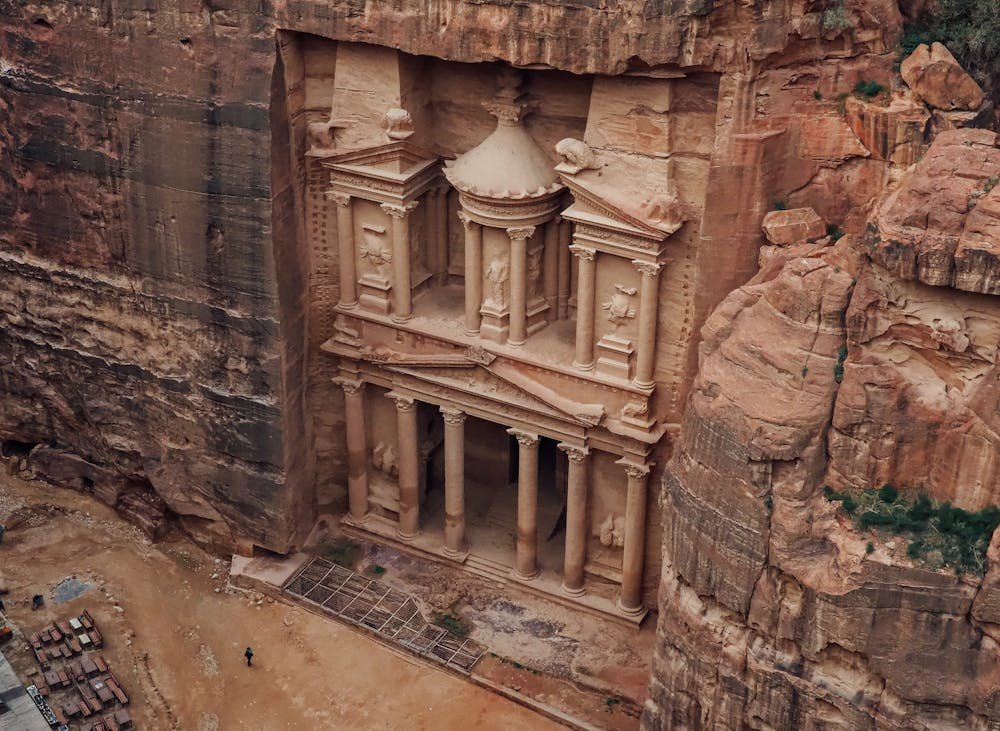Looking for best places to visit in Petra? Well, what you might not know is that this ancient city has rose-red cliffs that look like they jumped straight out of an Indiana Jones movie.
In other words, it’s one of those places that makes you go, “Wow, people actually built this?” And yeah, they did—way back in the 4th century BCE.
Speaking of which, Petra was the capital of the Nabataean Kingdom, a super-smart civilization that knew how to thrive in the desert.
In fact, they were masters of water engineering, which is wild because, let’s face it, deserts and water don’t exactly go hand in hand.
However, over time, Petra faded into the unknown until it was rediscovered back again in 1812 by a Swiss explorer named Johann Ludwig Burckhardt.
Anyway, why you must visit Petra, there should be a reason, right? Well, first of all, it’s a UNESCO World Heritage Site and also it is known as one of the New Seven Wonders of the World.
Which means that you have a lot to explore here, and as a help for you, we wrote this article by highlighting 15 of the best places to visit in Petra to give you the best experience that is possible.
15 Best Places to Visit in Petra
The Siq


The journey to Petra begins with The Siq, a narrow canyon that acts as the city’s natural entrance.
So, walking through The Siq feels like you are going into a different world—almost like nature itself is guiding you toward something extraordinary.
Whereas the towering cliffs on either side are dramatic by rising high above you and casting shadows that shift with the sun.
Anyway, as you walk deeper into the canyon, the anticipation builds.
In fact, you can’t help but wonder what lies ahead, especially if it’s your first time visiting.
Therefore, along the way, keep an eye out for remains of ancient water channels that are in the rock.
As a matter of fact, these channels were part of the Nabataeans’ genius water system, which allowed them to thrive in the desert.
Al-Khazneh (The Treasury)


Ah, The Treasury. This place is Petra’s most famous spot, the one you see on postcards, travel brochures, and Instagram feeds.
Speaking of which, as you step out of The Siq, the first look of Al-Khazneh is breathtaking.
Seriously, it’s one of those moments where you might find yourself standing there silently by just staring.
The reason for that is the carvings on its front are quite mesmerizing, whereas each detail tells a story from another time. And the sheer scale of it? Well, humbling.
Fun Fact: Parts of Indiana Jones and the Last Crusade were filmed here, which adds another value to this place.
Street of Facades


After enjoying your time at The Treasury, take a walk down to the Street of Facades.
Trust us, this row of tombs that are on the cliffside gives you a sense of how grand Petra once was.
In fact, it’s like walking through an open-air museum; instead of glass cases, you’ve got towering rock walls that are with historical aspects.
Speaking of which, each facade has its own unique design, whereas some are simple, while others are incredibly decorative by showcasing the skill of the Nabataean craftsmen.
Plus, take a moment to imagine what life might have been like here centuries ago.
The Royal Tombs


Next are the Royal Tombs, which are located high up on the cliffs.
Whereas these tombs are massive and give you a sense of the wealth and power of Petra’s rulers.
In fact, these weren’t just burial sites—these were historic places that people show respect even now.
With that thought, the Urn Tomb, the Silk Tomb, the Corinthian Tomb, and the Palace Tomb are the big four you can find here, each with its own distinct style.
As a matter of fact, some are with carvings, while others are more understated but no less impressive.
Anyway, climbing up to those offers stunning views of the valley below by making the effort well worth it.
So, as you stand there, surrounded by history and beauty, it’s hard not to feel a sense of awe. Whereas these tombs aren’t just stone; they’re legacies.
The Monastery (Ad-Deir)


If you’re up for a bit of a hike, make your way to The Monastery.
In scale, it’s larger than The Treasury and equally impressive, though less decorative.
Anyway, the climb involves around 800 steps, so prepare yourself for a workout.
As a matter of fact, when you finally reach The Monastery, you’ll feel a sense of accomplishment mixed with wonder.
Plus, there’s also a little café nearby where you can grab a drink and catch your breath while taking in the panoramic views.
The Great Temple


For history lovers, the Great Temple is a must-see.
It’s one of Petra’s largest excavated structures and gives you a glimpse into the city’s religious life.
Plus, the site is still being studied, and archaeologists are uncovering new details all the time.
Therefore, who knows what secrets it might reveal in the future? Well, anyway, walking through the ruins gives you a sense of the rituals and ceremonies that once took place here.
So, if you think about it, the Great Temple isn’t just a pile of stones—it’s a window into the spiritual heart of Petra.
On the other hand, even if history isn’t your thing, the sheer size of the structure is enough to leave you impressed.
The High Place of Sacrifice
This is another spot that requires a bit of effort to reach, but the panoramic views of Petra from the top are quite fascinating.
Speaking of which, the High Place of Sacrifice is believed to have been a site for religious rituals, and you can still see the remains of altars and ceremonial platforms.
As for the place, along the way, you’ll pass by rock-carved obelisks and other fascinating features that make the climb even more worthwhile.
Trust us, the higher you go, the more the area opens up by revealing Petra in all its glory.
Therefore, try your best to reach the top.
The Colonnaded Street
Once you’ve explored the temples or the tombs and feel like exploring something new, head to the Colonnaded Street.
Whereas this was the main street of Petra at its peak, lined with shops and public buildings.
Plus, you can almost imagine the vibe of ancient life as you walk along it, where merchants are calling out to customers, camels are carrying goods, and locals are going about their daily routines.
On the other hand, as of today, it’s a quieter area, but the energy of the past lingers by proving its history.
Therefore, if you feel like getting this vibe, make sure to spend a couple of days here to get the best experience that is possible.
Qasr al-Bint
Qasr al-Bint is one of the few structures in Petra, which makes it stand out from the many rock-cut buildings that are throughout the city.
It’s thought to have been a temple dedicated to the Nabataean god Dushara.
While the interior is mostly gone now, the exterior remains impressive, with thick walls and towering columns that hint at its former style.
Trust us, standing in front of Qasr al-Bint makes you to wonder about the ceremonies and gatherings that might have taken place here. As it serves as a powerful reminder of the spiritual side of Petra’s history.
Petra Museum


If you want to dive deeper into Petra’s history, check out the Petra Museum.
In fact, it houses artifacts that were found during excavations, including pottery, coins, and sculptures.
Moreover, the exhibits provide context for what you’ve seen in the archaeological park by helping you to piece together the story of this ancient city.
Trust us, from tools used in daily life to elaborate decorative pieces, the museum offers a closer look at the Nabataeans’ artistic side.
Whereas it’s a great way to wrap up your visit by giving you a fuller understanding of why Petra is such a remarkable place.
The Petra Church


The Petra Church is another highlight, known for its beautiful mosaics.
Whereas these mosaics are remarkably well-maintained and allows you to understand the aspects of the Byzantine era in Petra.
Speaking of which, look closely, and you might spot familiar patterns, such as birds and flowers, which add a unique touch.
Moreover, the church itself is an important place in the city’s evolution over time by blending Nabataean and Christian influences.
To be honest, you can actually relax at this place, as it is a quiet, meditative space where you can pause and find yourself on the layers of history that have shaped Petra.
The Garden Triclinium
This lesser-known site is often goes away from tourist attractions, which makes it a peaceful spot to explore.
As for its history, the Garden Triclinium is believed to have been a dining area for religious ceremonies, possibly used by priests or other important people.
Whereas its private location adds to its charm, because it is away from the main paths and offers a sense of peacefulness.
Therefore, as you walk through this hidden spot, you can’t help but appreciate the smaller, quieter moments of Petra’s history.
The Soldier’s Tomb


The Soldier’s Tomb gets its name from the sculpting of warriors on its front part.
In fact, it’s one of the many tombs that are scattered throughout Petra, whereas each tells its own story.
While some tombs are quite normal, this one stands out for its simplicity and symbolism.
Therefore, don’t forget to bring your camera as the lighting here is perfect for photos, especially in the late afternoon when the sun brings out a warm glow over the rock.
14. The Lion Triclinium
Named for the lion carvings in its entrance, this small structure is thought to have been another dining hall.
In fact, it’s a quiet, reflective spot that is away from the crowd, which is ideal for taking a break.
Plus, by sitting here, you can let your mind roam freely and imagine the conversations that might have taken place within these walls.
Anyway, the Lion Triclinium may not be as famous as The Treasury or The Monastery, but it has its own understated beauty.
Therefore, always remember that sometimes, it’s the quieter corners of Petra that leaves the biggest impression.
15. Little Petra (Siq al-Barid)
Just a short drive from Petra, you can find the Little Petra, which is smaller but equally fascinating as other places.
Speaking of which, it’s quieter and less crowded, which makes it a great alternative for those who want to escape the noise of the surroundings.
Plus, the painted cave here is particularly noteworthy as it’s one of the few places in Petra with original frescoes.
In fact, these paintings, though faded, give you the opportunity to see the artistic side of the Nabataeans.
Therefore, if you think about it, it’s the perfect way to end your adventure by leaving you with a sense of excitement and wonder.
Best Time to Visit Petra
Now, let’s talk about timing.
Petra is amazing year-round, but your time of visit can make a big difference.
In fact, the best times to go are spring (March to May) and fall (September to November).
This is because during these months, the weather is mild, and the desert isn’t scorching hot.
Plus, there are fewer tourists around compared to the peak summer months.
Petra Entry Fee & Jordan Pass Explained
Let’s get practical for a moment here.
The entry fee for Petra actually depends on how long you plan to stay.
For instance, a one-day ticket costs around 50 JD (Jordanian Dinars), while multi-day passes are available at a higher price.
On the other hand, if you’re planning to explore other parts of Jordan, consider getting the Jordan Pass.
Whereas it includes entry to Petra and over 40 other attractions, plus it waives your visa fee if you fly into Jordan.
Here’s a quick tip: buy your tickets online in advance. Also, if you’re staying multiple days, keep your ticket stubs as those will come in handy for re-entry.
How to Get to Petra
Getting to Petra depends on where you’re starting from.
For example, if you’re coming from Amman, the drive takes about 3 hours.
Whereas you can rent a car, hire a private driver, or take a bus.
On the other hand, from Aqaba, it’s a 2-hour drive, and from Wadi Rum, it’s about an hour.
Note: Many travelers combine Petra with a trip to Wadi Rum since both are desert destinations.
However, if you’re not comfortable driving yourself, guided tours are a convenient option in that case.
This is because they often include transportation, meals, and a guide, which can be a lifesaver if you’re short on time.
Where to Stay Near Petra
There are plenty of accommodation options near Petra that suit all budgets.
Speaking of which, for luxury seekers, hotels like the Mövenpick Resort Petra and the Petra Marriott Hotel offer comfort and convenience.
Moreover, mid-range options include the Old Village Resort and the Hyatt Zaman.
With that being said, if you’re traveling on a budget, guesthouses and hostels in Wadi Musa (the town closest to Petra) are affordable and comfortable as well.
Finally, camping is another option if you’re feeling adventurous.
Whereas several campsites near Petra offer tents and basic amenities.
Petra Travel Tips & Safety
Before you go, here are a few tips to make your trip much more enjoyable.
First of all, dress modestly, especially if you’re visiting during Ramadan or entering religious sites.
Speaking of which, loose, breathable clothing is ideal for the desert heat. Whereas comfortable shoes are a must as you’ll be doing a lot of walking.
In addition to that, guides can enhance your experience, but they’re not mandatory.
In fact, if you choose to hire one, make sure that they’re licensed.
Also, be aware of scams, like people offering unofficial “discounted” tickets or unsolicited help by carrying your bags.
With that being said, Petra is generally safe, even for solo travelers. However, always stay aware of your surroundings and keep your belongings secure, just in case.
Conclusion
Petra is one of those places that leaves a lasting impression.
Whether you’re exploring the Treasury, hiking to the Monastery, or discovering a hidden spot like Little Petra, there’s something for everyone.
Trust us, with a bit of planning, you can make the most of your visit without losing your savings or melting in the heat.
So pack your bags, lace up your shoes, and get ready for an adventure that you’ll never forget.
This is because Petra is waiting to share its secrets with you.
Contact Travelco Holidays to book Jordan tour packages.
FAQs
The Treasury (Al-Khazneh) is Petra’s most iconic spot and the one most people recognize.
Two days are perfect, as in one day to see the highlights and another to explore lesser-known spots.
Yes, you can explore Petra independently, though hiring a guide can add depth to your experience.
Absolutely! Petra is safe for solo travelers, but always stay alert and take standard precautions.
Wear loose, breathable clothing and comfortable shoes. Plus, a hat and sunscreen are also essential for sun protection.


Editorial Staff at Travelco are experts in Global Tourism.

